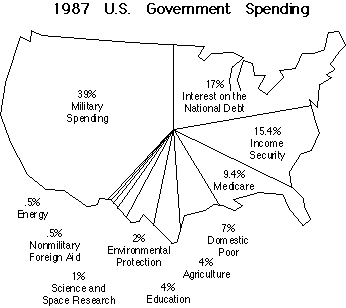Dana Meadows is a well-known pioneer in the field of sustainability. She is a Dartmouth educator, a co-author of the ground-breaking Limits to Growth, and now a principal organizer of the Balaton Group. She writes a column called The Global Citizen which should be carried by your local newspaper. If not, write to your editor – and to Dana at P.O. Box 37, Plainfield, NH 03781 – to get her regular reports into its pages.
We can’t afford to keep the post offices open full time. We can’t fix the roads or educate our children properly. Whenever a political candidate proposes to fight drugs or shelter the homeless, the other candidates respond in a chorus, "But where are you going to get the money?" as if money had suddenly become scarce.
In an election year, a lot of flapdoodle fills the air – we’re worse off, we’re better off, we’ve gotten the government off our backs, we’ve the shifted the government from the backs of the rich to the backs of the poor. It helps in these windy times to hang on to a solid mooring of facts. A simple comparison of national economic figures from 1980, the last year of the Carter administration, and 1987, the most recently completed Reagan year, says a lot about what we can afford and who is paying for it.
Money is not scarcer than it was in 1980. The Gross National Product rose by 60% between 1980 and 1987; about two-thirds of that rise was due to inflation. The real money value of our annual consumption of goods and services, then, increased by roughly 20%.
The Reagan revolution has not gotten government off our backs. We paid in taxes 18.9 cents per dollar of GNP back in 1980, and 19.4 cents per dollar in 1987. In both years, nearly half of the government’s receipts came from personal income taxes. The share coming from corporate taxes dropped from 13% to 9.8%; the share from Social Security payroll taxes rose from 27% to 32%. That means about $30 billion of the annual tax bite was shifted from corporate tax to payroll tax – from the profits of owners to the wages of workers.
The government spent 21.6 cents of every GNP dollar in 1980 and 22.8 cents of 1987. Since that was more than the government took in, there were deficits both years. To make the deficit look smaller, government accountants like to lump together the self-financing Social Security system with the rest of the budget. Social Security made a surplus of $21 billion in 1980 and $66 billion in 1987. The rest of the government was in the red by $94 billion in 1980 and $217 billion in 1987.
Leaving out Social Security, President Carter’s government spent $472 billion in 1980, President Reagan’s $798 billion in 1987. Where did all that money go?

The largest chunk by far went to the military and to veterans – 33% of government spending ($155 billion) in 1980; 39% ($309 billion) in 1987. That doesn’t count the nuclear weapons in the energy budget, or the military part of the space budget, or the military aid in the foreign aid budget, or the Pentagon’s share of the interest on the federal debt. If we add in those indirect costs, about half of our 1987 tax dollars went directly or indirectly to military purposes.
After the military, the next three big items in both budgets were income security, interest on the national debt, and Medicare. Income security (unemployment and disability insurance, federal employees’ retirement benefits, and all forms of welfare) went down from 18.3% to 15.4% of government spending. Medicare increased from 6.8% to 9.4%. The biggest increase was in interest payments, as the Reagan deficits nearly tripled the national debt. Interest went up from 11% of the budget ($52 billion) in 1980 to 17% ($139 billion) in 1987.
These three items plus defense made up 69% of Jimmy Carter’s budget and 81% of Ronald Reagan’s, which is to say that all other government functions squeezed from 31% of Carter’s budget to only 19% of Reagan’s. That is the pinch we are feeling now. Between 1980 and 1987 the fraction of the budget spent on education was cut nearly in half. Also cut in half were nonmilitary foreign aid, environmental protection, and community development. Transportation was cut by a third, energy by two-thirds (almost nothing is left there but nuclear).
In short, the government spent more money and a higher proportion of the national income in 1987 than in 1980. Its priorities shifted greatly, away from nearly all domestic concerns, toward military spending and interest on the mounting debt. For every dollar we paid in income tax last year, 39 cents went directly to the military, 17 cents to debt interest, 7 cents to the domestic poor, 4 cents to education, 4 cents to agriculture, 2 cents to environmental protection, 1 cent to science and space research, half a cent to energy, half a cent to nonmilitary foreign aid.
Those are the priorities chosen by the people we elected to the Congress and presidency over the past seven years. We get to elect a new bunch this year. While we listen to the candidates and make our choices, we should remember that we surely can afford to fix up the highways, clean up toxic dumps, give our children an excellent education, and keep the budget in balance. We can even keep the post offices open. If we want those things to happen, though, we have to elect people who will choose to spend our money that way.






